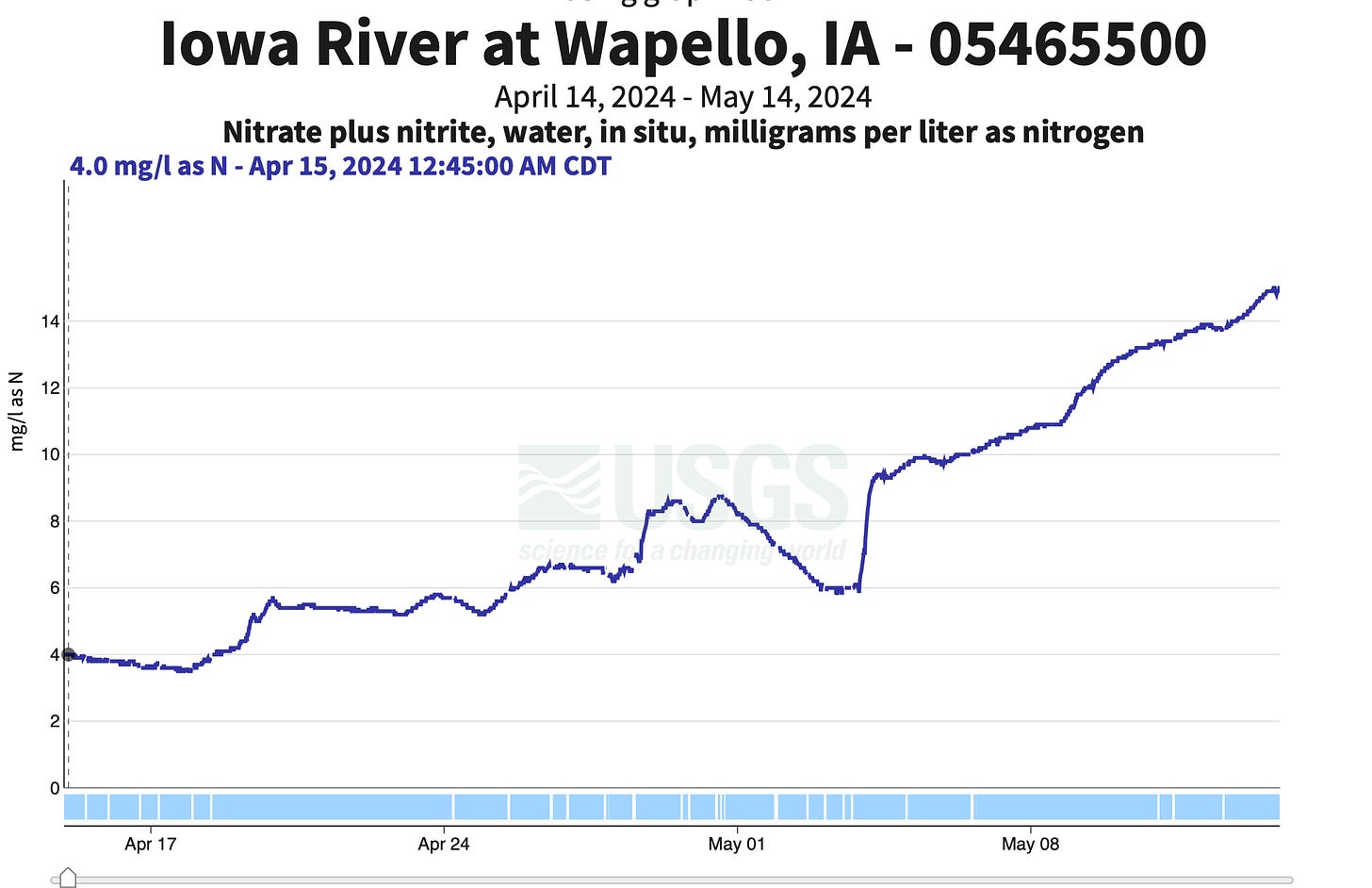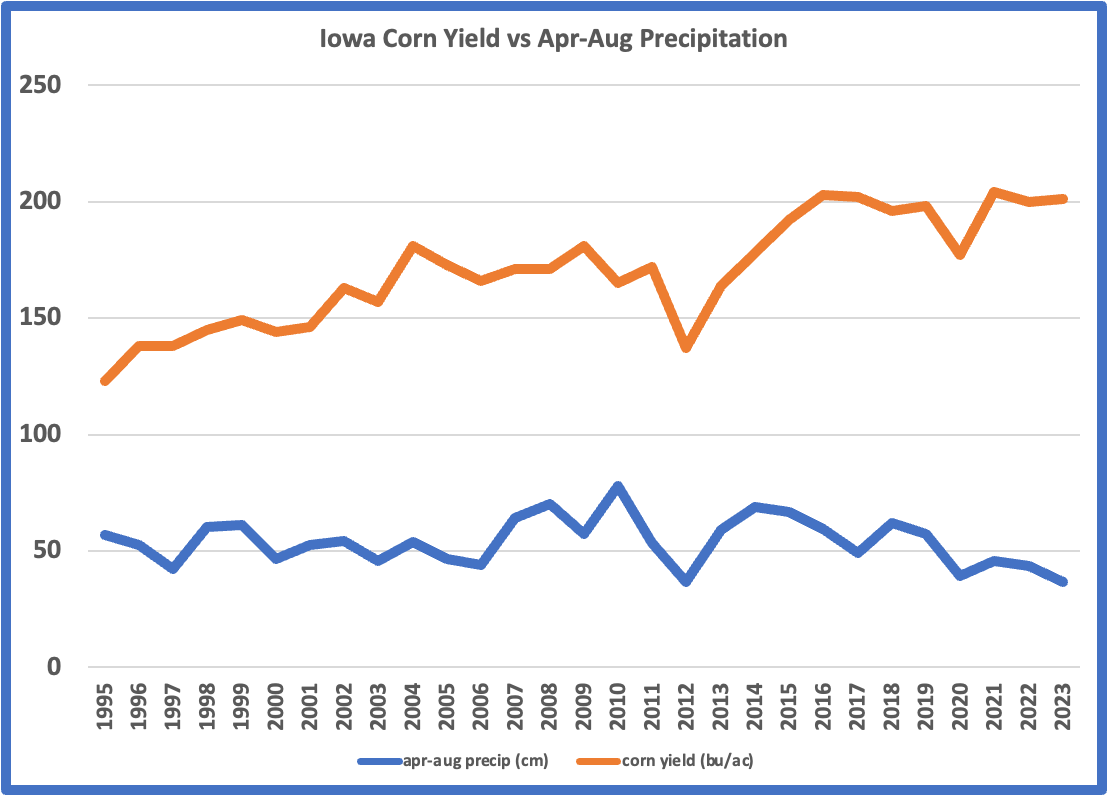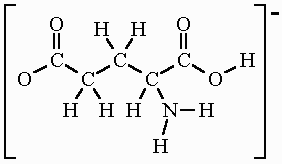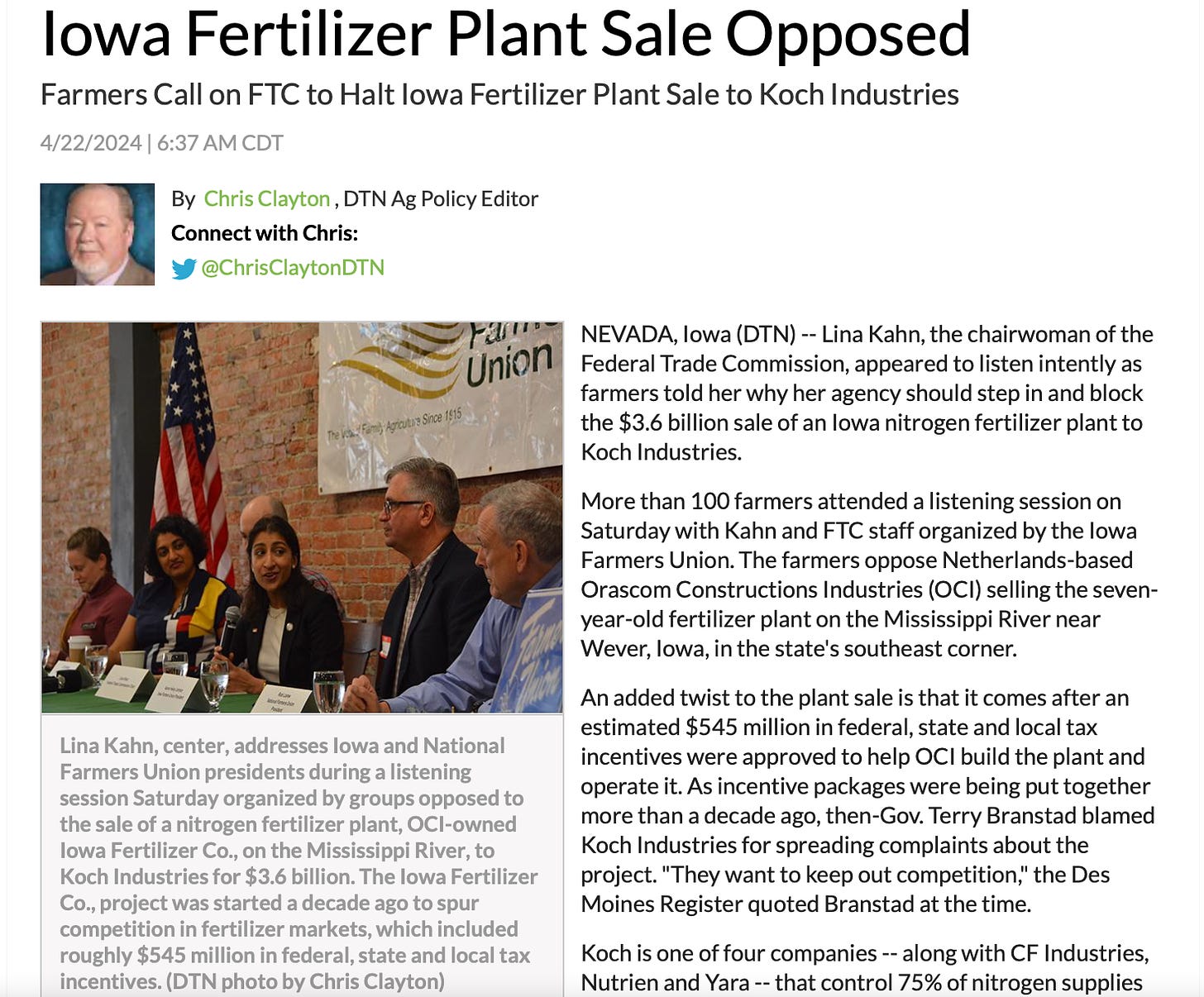After a four-year drought, Iowans are seeing some spring weather they vaguely remember, that is, rain. There’s been enough rain, as a matter of fact, that I was able to stumble upon seven whole morel mushrooms. Truth be told, it hasn’t really been wet, but normal; statewide average rainfall for April was just shy of 5 inches and May rainfall thus far has been about 3.5 inches. Anything less than that and we’d still be griping about dryness.
That has been enough rain, however, to send stream nitrate into the stratosphere over the past two weeks. Several Iowa streams blew right by 20 ppm (as N) to flirt with 30-something, including the Boone River and the South Fork of the Iowa River. The regulatory standard for municipal drinking water is 10 ppm. Even normally low-nitrate streams like the Nodaway River (12 ppm) were delivering the gift of green water and a gasping Gulf to our compatriots in Louisiana. As I write this, 1.6 million pounds of nitrate-nitrogen are passing the Iowa River gaging station in southeast Iowa, *every day*. That’s the equivalent of 11 rail cars of anhydrous ammonia. One river. One day. Eleven rail cars.

Of course, the people that study these things including me have been warning of this impending circumstance for a while now. It’s been shown time and time again that stream nitrate is worst in a post drought condition. Why? Because nitrate is accumulated in the soil by 1) lack of normal loss from crop fields to the stream network during dry years, and 2) poor nitrogen uptake by corn when moisture is in short supply. Number 2 usually results in reduced corn yields, but….statewide corn yields in Iowa the last three years have been 204, 200, and 201 bushels per acre. Only two other times in the GMO era (1995-now) have statewide corn yields exceeded 200 bu/ac (2016 and ’17).
Farmers apply nitrogen fertilizer to corn fields. When and what type of nitrogen is applied varies. Nitrogen is usually not applied in the nitrate (NO3) form but is converted to nitrate by natural soil processes. The most commonly applied product (in terms of pounds nitrogen applied) is anhydrous ammonia (NH3). Ammonia sticks pretty well to soil particles but once it is oxidized to nitrate, it’s off to the races, assuming there’s water to move it around.
Iowa’s Department of Agriculture and Land Stewardship (IDALS), which could be more accurately named Iowa Department of Agriculture or Land Stewardship, tracks commercial fertilizer sales. For the 2023 crop year, 2.39 billion pounds of nitrogen were sold in commercial formulations. The overwhelming majority of this is applied to corn, and while it’s impossible to know exactly what that percentage is, I think I’m anchored in a pretty safe harbor by saying it’s at least 90%. From that, 90% of 2.39 billion is 2.15 billion pounds.
USDA tracks how many acres are planted to corn in Iowa and other states. In 2023, that was 13.1 million acres in Iowa. 2.15 billion pounds divided by 13.1 million acres is 164 pounds per acre. Using Iowa State’s N rate calculator, the recommended amount of nitrogen for corn grown in rotation with soybean is 146 lbs/acre and for corn grown following corn it’s 184 lbs/acre. Based on that, you might be inclined to say most Iowa farmers are well aligned with recommendations. But let me remind you that there are two guys in this elevator, one named Commercial and the other one named Manure, and when one of them farts, it’s impossible to know who done it because they’re both pretty flatulent.
I’ve heard Dan Anderson at Iowa State say that manure comprises about 40% of Iowa’s nitrogen inputs. This agrees pretty well with some of my own analysis of a few years ago. Tack 40% onto 2.39 billion pounds and suddenly you’re at 4 billion pounds of nitrogen, which pencils out to 305 pounds of nitrogen per corn acre statewide. Now the aggies will say butbutbutbut a lot of that manure N is not plant available (yet) or it evaporates into the air and my response is thank you for admitting you lose your nitrogen. It doesn’t just harmlessly float off into the Milky Way; it enters our streams, lakes and aquifers and is a strong contributor to greenhouse gas warming.
During dry years the surplus nitrogen applied by farmers gets banked in the soil. Then when the rains come, soil moisture acts like a lance on a pus-filled boil and stream nitrate goes through the roof. But industry hacks, and unfortunately, Iowa State University agronomists, grow tongue hair trying to explain how all this pollution is because of ‘soil mineralization’. High-organic soils like we have here in Iowa contain a lot amino acids like glutamic acid, aspartic acid, alanine, and histidine. ‘Amino’ implies nitrogen in chemistry. When these compounds are exposed to oxygen, they are ‘oxidized’ in a process often mediated by bacteria, and the nitrogen contained within ends up as nitrate (NO3).
Of course, the aggies neglect to tell you about all the things they do to hasten the mineralization process—tillage and drainage tile being the two biggies. And, newsflash, corn *can* use that mineralized nitrogen. There are even products now that farmers can buy that accelerate the process!! Even still, farmers deny they are at fault for nitrate pollution like a kindergartner denies eating boogers, even when they’re caught red-handed.
As result of this tomfoolery and our unpredictable weather, we’re stuck in this wash, rinse and repeat routine where the ag establishment crows about conservation during the dry cycle and then blames the weather when the rains return. But the weather is what it is—and agriculture can design its systems around the expected range of weather conditions—or not. They choose not. And then blame the public for not being willing to pay for it.
More than a few university faculty have been helping the nitrogen-selling industry sweep the over-application of nitrogen under the rug for 30 years at least. These people are a disgrace to what it means to be a scholar and a public servant. And yes, I get there is pressure from university administrators who want agribusiness giants to advertise at sporting events and pay for new buildings and labs and drinking fountains and such, but when an entire state’s water is polluted with nitrate and human health effects seem increasingly likely every day, these people do not deserve our respect or our sympathy, and I hope they and their students are reading this.
You might have heard that Koch Industries purchased the 7-year-old Orascom fertilizer plant in Weaver, Iowa that taxpayers helped build to the tune of $550 million, courtesy of Terry Branstad. Branstad justified this at the time by saying (surprise!) Koch Industries was trying to keep out the competition and Orascom needed our help to bring cheap fertilizer to Iowa farmers. Rumor has it that good ol’ Terry thought his hero Donald Trump’s book was called Fart of a Deal and acted accordingly on the Orascom scheme. Anyway, there has been a sprained ankle epidemic on the political left in recent weeks as they trip over themselves rushing to farmers’ defense against future price gouging by Big Bad Koch. Lucky for them George Soros isn’t in the fertilizer business, I guess.
Can we ruminate for a second on why Koch sees the fertilizer business as so attractive (and lucrative)? Recall the old Tom Ryan comedy bit when he calls the Arm and Hammer baking soda marketing people geniuses for convincing people to buy their product and then POUR IT DOWN THE DRAIN.
David Koch, to brother Charles (before he died): Chuck, here’s a business where the customers religiously buy 40% more of a product than they need, and they barely care how much it costs.
Chuck: Dave, c’mon, I thought we agreed to steer clear of the booze business out of respect to dear old Mom.
Dave: No, no, no, I’m talking about something way bigger: fertilizer. The customers get hooked easier than a starving channel cat.
Chuck: But won’t somebody be responsible for the pollution caused by the 40%?
Dave: That’s the beauty of it, Bro! The f-ing taxpayer will pay to clean up the mess! And both political parties are down with it! It’s the perfect business opportunity!!!
Chuck immediately dies of a heart attack, leaving David to get even richer.
Moral of the story: why on earth should I or any other Iowan care how much farmers are paying for the nitrogen fertilizer that pollutes our water from Correctionville to Keokuk? And bear in mind that most of this fertilizer is going to corn grown for fuel ethanol so guys like Bruce Rastetter can make sense out of their existence by adding zeros to their net worth. On second thought, maybe we should care how much farmers are paying for fertilizer. We should beg Koch Industries to gouge the shit out of their customers so they might think twice before using so much.







This is very excellent and informative and well written article. THIS IS NEWS
By taxpayer largess for crop subsidies and insurance and mandated "choice" of 10% corn ethanol at the gas pump, we non-farmers are also paying for those train cars of excess nitrogen flowing under the bridges. So, yeah, we get the costs -- capital, environmental, ecological, health, climatic and aesthetic -- of the "freedom to farm" in all its undemocratic and unaccountable ways. So, give us the "choice" of 15% corn ethanol and save us from the evil EV socialists!